The main human challenge in biodiversity conservation is the lack of basic information on distribution, abundance, habitat requirements and threats. To obtain this data, efficient and specific methods are needed to detect and quantify diversity. From this need and the collaboration of several scientists and research teams over the years, the technique of environmental DNA was born.
What is environmental DNA?
Environmental DNA or eDNA is an efficient, non-invasive and easy-to-standardise sampling approach with great potential as an environmental monitoring tool. This methodology allows sequencing (determining the exact order of bases in a DNA strand) of many organisms at once using the metabarcoding technique and is therefore a very important tool for biodiversity determination and ecosystem characterisation in both terrestrial and aquatic environments.
Environmental DNA also allows the early detection of invasive species, as well as the detection of rare and/or difficult to detect species and the study of the diet of a species. Thus, the potential of environmental DNA in biological research seems almost limitless.
Applications of environmental DNA
The applications of environmental DNA are diverse. From biodiversity monitoring to early detection of invasive species, this technology offers new insights into life on our planet. In addition, environmental genomics is increasingly used in environmental monitoring and assessment of human impact on ecosystems.
Its main applications are the following:
- Detection of rare, endangered and invasive species: repeated sampling with conventional surveys is expensive and can cause irreparable damage to the target organism or its habitat. Thus, environmental DNA offers a cost-effective approach to non-invasive monitoring of such species.
- Estimating species distributions: Monitoring some species remains a challenge, partly because of their geographical distributions, limited understanding of their lifestyles and methodological limitations. Environmental DNA analysis improves this large-scale monitoring.
- Biological monitoring of ecosystem health and dynamics: Biological invasions, pests and diseases are among the most serious threats to global biodiversity. Safeguarding biodiversity is synonymous with safeguarding the economy and public health. One of the challenges is to detect these harmful effects, especially when they are found at low density. Environmental DNA has proven to be a highly effective sampling method capable of monitoring the spread and establishment of harmful biological agents through early detection, analysis of spread patterns and assessment of population dynamics.
- Diet analysis and trophic interactions: an effective method was needed to understand and quantify biotic interactions, as predator-prey and host-parasite relationships are key components of ecological research. Environmental DNA is increasingly used in diet analysis to estimate the diversity, composition and frequency of occurrence of prey items in predator faeces. In addition, DNA deposited by pollinators on flowers and by dispersers on seeds is also used to investigate plant-pollinator interactions and the role of these interactions in maintaining ecosystem functions.
- Spawning ecology: identifying spawning grounds is key to the effective management and conservation of these species. Until now, understanding the natural reproductive ecology of these organisms was done by collecting eggs, larvae and adults under spawning conditions, sometimes in areas of water depth or times of day different from those where spawning actually occurs. Environmental DNA allows, in a non-invasive way, the detection of a species regardless of its life stage or sex.
- Biodiversity monitoring and study of ancient ecosystems: this application is especially useful in megadiverse regions with many rare species. Environmental DNA has increased our ability to monitor past and present biodiversity.
- Pollution response: environmental DNA is mainly used to study environmental responses to changes caused by pollution. It is also used to find out how likely a species is to survive or not survive a pollutant. This provides information on the severity of the pollutant**.
- Air quality analysis: this analysis usually focuses on the characterisation of the microbiome, fungal communities and/or airborne pollen. The
The study of the microbiome in the air allows the assessment of its potential toxic or allergenic effects on human health and the environment*.
Environmental DNA methodology
The environmental DNA methodology consists of five phases:
- Sampling: collection of environmental samples in water, air, sediment and soil. Sampling should be representative and carefully planned to capture the diversity of organisms present in the environment.
- Isolation: once the samples have been collected, DNA is isolated from the organisms present in the samples.
- Sequencing: this involves determining the exact order of the bases in the DNA chain. At Eurofins Environment Testing Spain we use Next Generation Sequencing.
- Computational analysis and processing: bioinformatics analysis to identify and characterise the organisms present in the sample. This may include comparison of DNA sequences with databases of known sequences. Also identification of specific genes, quantification of diversity and abundance of organisms.
- Interpretation: interpretation of the information to understand the composition and function of the microbial community.
Eurofins Environment Testing Spain, at the forefront of the field
Eurofins Environment Testing Spain, the largest network of environmental laboratories in Spain, offers environmental DNA analysis as a service for all types of applications. We use the most advanced methods of analysis: Next Generation Sequencing (NGS) and Quantitative Real-Time PCR (qPCR). Are you interested in this type of services? Find out here how we can help you.
*(Kingsly C. Beng, Richard T. Corlett, 2020). Applications of environmental DNA (eDNA) in ecology and conservation: opportunities, challenges and prospects.
** (Huerta Vela A., 2020). Applications of environmental DNA techniques in environmental sciences.

